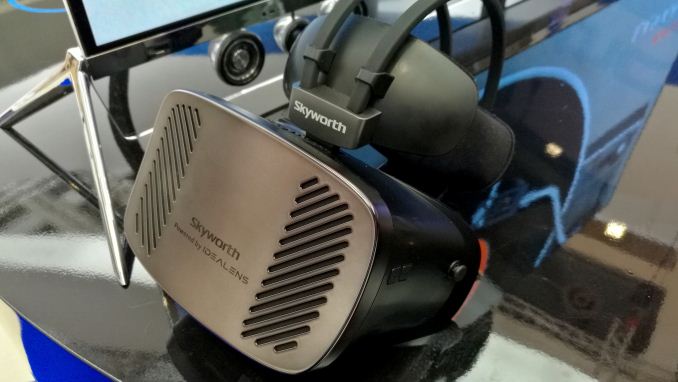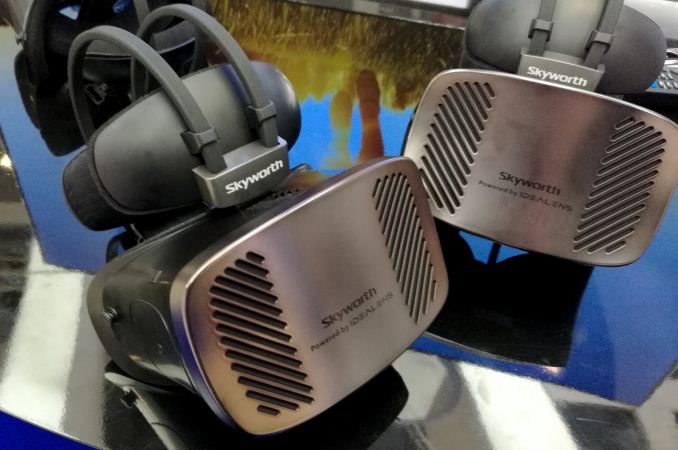IFA 2016: Examining the Malaise of Bargain Basement Virtual Reality
by Dr. Ian Cutress on September 9, 2016 9:00 AM ESTGoing Above $100: The Skyworth AIO-VR
In the last few minutes of the show I was steered towards the Skyworth booth in a different hall and told to go see their all-in-one headset. I was told that in comparison to the others, the Skyworth offering might be a substantial substitute above the cheap VR on display. The problem is always the cost, which we’ll get onto in a minute. The Skyworth VR setup was on display to test, however there were no specifications on display, and we weren’t allowed to take a picture of the image on the demonstrator’s phone that had all the hardware listed, but I was able to memorize a few key points.
It’s worth saying that the Skyworth AIO-VR was slightly bulkier than the other headsets, if only because the mechanism to mount it on your head was a plastic part of the design, aimed at balancing the weight a little but also securing it more firmly with padded guards. The outside was still plastic, however with a brushed metal look, and slightly more attention to detail.
The units were up and powered, and after putting it on I could tell the interface was smooth. Don’t get me wrong, the pixels were still quite obvious, but moving my head showed a high frame rate display better than the 30/60 Hz offerings of the cheaper implementations.
As far as I could jot down in a reasonable time, the headset uses an Exynos 7420, which is a 4x4 big.Little design using quad ARM Cortex A57 at 2.1 GHz and quad ARM Cortex A53 cores at 1.5 GHz on a 14nm process. The 7420 also uses Mali-T760MP8 graphics, at 772 MHz, which is good for 210 GFLOPs, and is paired with dual-channel (2x32-bit) LPDDR4. This SoC was powering dual 1080x1200 displays inside, which is a formidable number of pixels, and I saw that we’re looking at a 3800 mAh battery. Other specifications I can’t remember, though one would assume a 4GB/64GB arrangement for memory and storage if this was a smartphone.
So here’s the thing: the Skyworth headset is essentially a smartphone under the hood that you can’t take out. So what makes it better than a Samsung VR headset where the smartphone can be attached / detatched? One would assume it’s a price thing, and we were told the price for the headset could be $400 to $800. I remarked that it was a pretty large range, but was told that the Skyworth headset is still a work in progress, with exact specifications to be decided later. If it was $400, it might be more palatable, but for $800 then it might be easier to go the smartphone route.
The Problem with Low Cost VR
This brings us around to the problem with VR right now. Everyone wants in on the bandwagon, and in a keynote at the event it was pointed out that in order for triple-A style games and film studios to start making content in these new formats, there needs to be more potential sales out there. Current estimates put 500k headsets in the market (of varying degrees of power) with another 2.7 million by the end of 2017. No game studio or film studio, working on the next FPS or Avatar, will make a massive piece of content for only 3.2 million people – it needs to be in the hands of tens of millions to even start to make sense, and we won’t be at that point for a number of years.
All that being said, you have a choice – investing in a premium VR headset to be able to experience the best will cost $700+, in terms of the headset itself plus any extra hardware you need to power it. The easiest way to enter the VR space with some clout is the smartphone or all-in-one route, but that is still a hefty cost. Then there is a large, long gap to the segment of very basic all-in-one virtual reality headsets as shown at IFA this year.
For $100, or the rough price of the Samsung headset without any internal hardware, you get a basic quad-core Rockchip design with limited functionality. I’m half inclined to suggest that a bucket be provided as well, just in case nausea takes over. But it shows what a state VR is in, when the hardware is still so expensive. In order to get a base experience that can truly be called VR, such as with the Skyworth headset, it might be as much as a high-end smartphone anyway. For mass market adoption, the cost to enter has to be low, but not so low we’re scraping the barrel for basic frame rates.
Picture Galleries















































59 Comments
View All Comments
Morawka - Friday, September 9, 2016 - link
these are cheap VR porn viewing devices... nothing morepiiman - Sunday, September 11, 2016 - link
What more could you want? :)stephenbrooks - Friday, September 9, 2016 - link
Well, despite the interaction with software, VR is fundamentally a display technology. The Oculus and HTC understand this as they use an external computer. The GearVR and cardboard understand this as they use your existing smartphone. "All-in-one" units are ALWAYS going to be on the wrong side of the economics equation and can only only really sell themselves on convenience. So looking at cheap AIOs gives the result you'd expect.jaggedcow - Friday, September 9, 2016 - link
I wouldn't be surprised if Apple released a $2000-3000 all in one VR headset since they love integration, but I think the vast majority will be cheaper modular displays (possibly with extra sensors or gyros) where you slot in an upgradeable SOC of your choiceSushisamurai - Friday, September 9, 2016 - link
Wow, that was a lot of data to remember hah, good job there. Yeah, I've tried some of the "cheap Chinese" VR sets that have been cropping up around China as "entertainment booths". Some are pretty rough and nauseous and most are not comparable to the Vive. I wonder if there were any cheap tethered VR's and what were they like... I could see that expanding the VR populationRaichuPls - Friday, September 9, 2016 - link
So when are you going to examine the S820 and the HTC 10 and the RX480/470/460?fanta666 - Friday, September 9, 2016 - link
Only when htc sends them the chequeBrokenCrayons - Friday, September 9, 2016 - link
I'm not personally concerned with the S820 or HTC 10, but I would like to see the in-depth stuff for the AMD GPUs. I hate to complain/derail/etc in the comments box, but AT does a really good job with digging into graphics cards so I'm keenly interested in seeing your take on the 460 in particular.theduckofdeath - Monday, September 12, 2016 - link
Tom's Hardware has always been better for GPU reviews. They do them timely and have neat tables where you can compare different brands according to specific game and/or resolutions so you know exactly which will suit you best.artk2219 - Wednesday, September 14, 2016 - link
Since AT was bought by the same company that owns Toms, they're basically two people sharing the same umbrella. Don't get me wrong I love both sites, but I have noticed they've become much more similar since that transition.